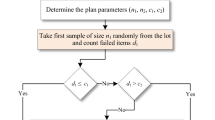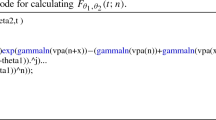Abstract
For costly and/or destructive tests, the sequential method with a proper maximum sample size is needed. Based on Koopman-Darmois distributions, this paper proposes the method of sequential mesh, which has an acceptable maximum sample size. In comparison with the popular truncated sequential probability ratio test, our method has the advantage of a smaller maximum sample size and is especially applicable for costly and/or destructive tests.
Similar content being viewed by others
References
Anderson T W. A modification of the sequential probability ratio test to reduce the sample size. Ann Math Statist, 1960, 31: 165–197
Bilias Y. Sequential testing of duration data: the case of the pennsylvania “reemployment bonus” experiment. J Appl Econometrics, 2000, 15: 575–594
Donnelly T G. A family of truncated sequential tests. Dissertation for the Doctoral Degree. NC: University of North Carolina, 1957
Huffman M D. An efficient approximate solution to the Kiefer-Weiss problem. Ann Statist, 1983, 11: 306–316
Ingeborg T, Paulus A H N. Early stopping in clinical trials and epidemiologic studies for “futility”: conditional power versus sequential analysis. J Clinical Epidemiology, 2003, 56: 610–617
International Electrotechnical Commission. International Standard of IEC 1123: Reliability testing compliance test plans for success ratio, 1991–12
Kiefer J, Weiss L. Some properties of generalized sequential probability ratio tests. Ann Math Statist, 1957, 28: 57–75
Lai T L. Optimal stopping and sequential tests which minimize the maximum expected sample size. Ann Statist, 1973, 1: 659–673
Lai T L. Sequential analysis: some classical problems and new challenges. Statist Sinica, 2001, 11: 303–408
Lorden G. 2-SPRT’s and the modified Kiefer-Weiss problem of minimizing an expected sample size. Ann Math Statist, 1976, 4: 281–291
Marano S, Willett P, Matta V. Sequential testing of sorted and transformed data as an efficient way to implement long GLRTs. IEEE Trans Signal Process, 2003, 51: 325–337
Pu X L, Yan Z G, Mao S S, et al. The sequential mesh test for a proportion (in Chinese). J East China Norm Univ Natur Sci Ed, 2006, 1: 63–71
Wald A. Sequential Analysis. New York: Wiley, 1947
Author information
Authors and Affiliations
Corresponding author
Rights and permissions
About this article
Cite this article
Li, Y., Pu, X. Method of sequential mesh on Koopman-Darmois distributions. Sci. China Math. 53, 917–926 (2010). https://doi.org/10.1007/s11425-009-0096-5
Received:
Accepted:
Published:
Issue Date:
DOI: https://doi.org/10.1007/s11425-009-0096-5
Keywords
- method of sequential mesh
- sequential probability ratio test (SPRT)
- Koopman-Darmois distributions
- maximum sample size




